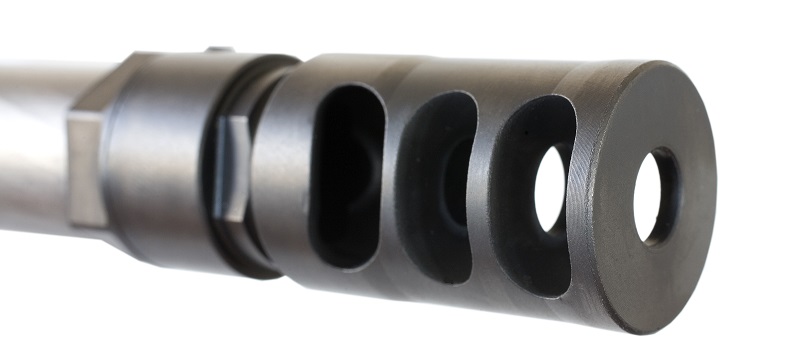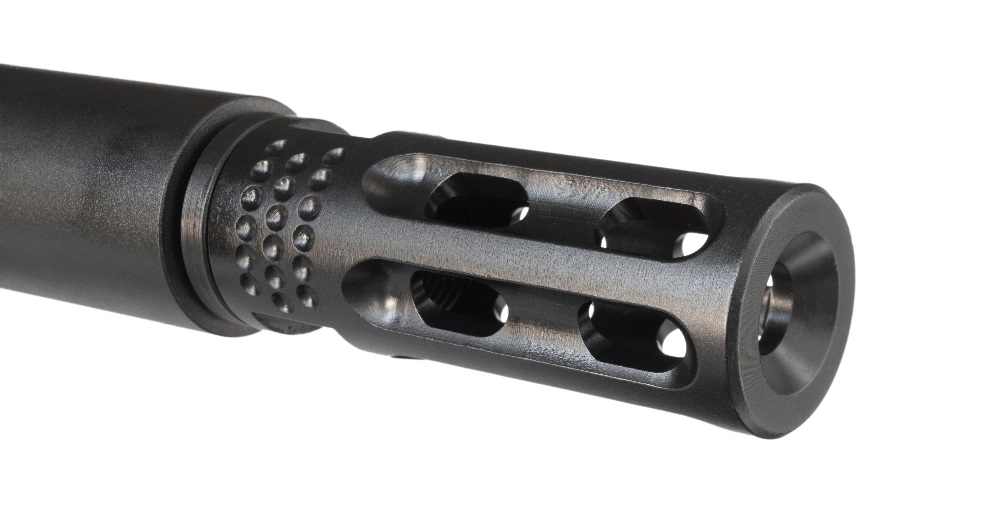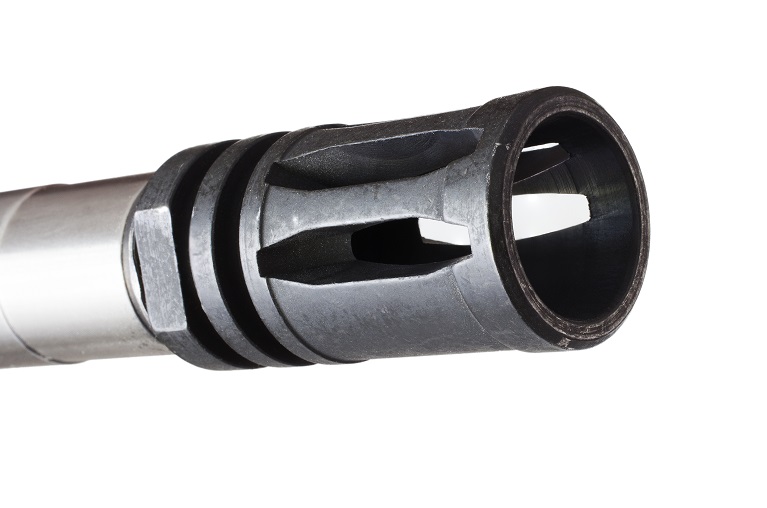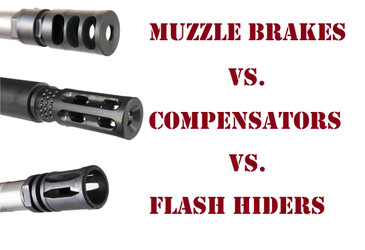Muzzle Brakes vs Compensators vs Flash Hiders
Posted by Gun Builders Depot on Jan 27th 2022
Your AR-15's barrel can be fitted with loads of muzzle devices. Muzzle brakes, compensators, and flash hiders are all popular choices among AR owners. Which one should you get, and why? We're comparing what each muzzle device does. Let's dive in.
The Muzzle Brake

A muzzle brake does exactly what its name implies: It literally brakes your rifle or pistol backward motion caused by recoil caused when you pull the trigger. It does this by redirecting all gasses exiting the barrel back toward the shooter. This opposing force helps reduce felt recoil, improving accuracy and rapid fire capability.
What does a muzzle brake do?
Muzzle brakes reduce felt recoil, making them ideal for high-caliber rifles and pistols chambered in large calibers. Magnum loads and heavy rounds like .50 Beowulf or .458 SOCOM benefit the most from a good muzzle brake.
What does a brake look like?
Muzzle brakes look like compensators and the two are often confused for each other. But if you look closely, you'll notice the typical muzzle brake uses side vents that redirect toward the sides of the firearm or back toward the shooter. The brake pictured above represents the common design.
Pros and Cons
Although a muzzle brake can reduce felt recoil and making shooting your rifle or pistol more comfortable, there are drawbacks. By redirecting gas toward the shooter, a muzzle brake tends to make a firearm sound louder. Brakes that redirect gas to the sides can also cause discomfort to nearby shooters when at a seated range.
The Compensator

At first glance, the compensator looks like a muzzle brake. Mechanically, a compensator works just like a brake: It redirects all gas exiting the muzzle via ports cut into the device. Unlike the recoil-reducing muzzle brake, a compensator reduces muzzle rise.
What's muzzle rise?
Every time you pull the trigger, your rifle's or pistol's barrel has a tendency to rise upward. This effect obscures your sight picture, reduces rapid fire capability, and forces you to reset your point of aim after each shot. The compensator greatly reduces this effect, providing a "locked in" point of aim that doesn't sway from the target as much.
What does a compensator look like?
The average compensator looks like a brake. Except its ports don't all redirect gasses to the sides or back toward the shooter. The compensator uses ports redirected upward at various angles, creating an opposing downward force that helps reduce muzzle rise with each trigger pull.
Can a compensator be a brake?
Yes. Compensators and brakes are not separated by any specific design element. If a muzzle brake reduces muzzle rise, it can be considered a compensator. A compensator that reduces felt recoil can be considered a muzzle brake. Some even do both by design!
Pros and Cons
A compensator is arguably the best performing-enhancing muzzle device, but it isn't without cons: By redirecting excess gas upward, the shooter's sight picture could be partially obscured by his or her compensator. This only becomes problematic with large cartridges and very short barrels, wherein excess gas can produce bright flames and flashes.
Speaking of flashes, let's look at the last type of muzzle device.
The Flash Hider

Go to any gun store selling AR-15s, and you'll find one of these lil' guys fixed to most of the barrels behind the counter. The device above is the A2-type, or M16-style flash hider, developed decades ago by Eugene Stoner. Flash hiders like these are the most popular and common muzzle devices you'll find on retail tactical rifles and AR-15s at gun stores.
What does a flash hider do?
Like everything else here, the flash hider does as it is name says: It hides muzzle flashes that are created when gas exits the muzzle and ignites, producing a bright flame. While compensators and muzzle brakes are made to improve a shooter's performance, the flash hider was designed only to help conceal a shooter's position by reducing muzzle flash.
What does a flash hider look like?
Flash hiders are typically made with long, thin ports or open-ended prongs. These ports and prongs disrupt expanding gas that forms at the muzzle, preventing it from igniting and forming a bright flash.
Can a flash hider be a comp or brake?
Certainly. The A2 flash hider above redirects all gasses upward, just like a compensator. This design reduces muzzle flash and muzzle rise, providing a performance benefit in addition to tactical concealment when firing. Other flash hiders may have ports redirected out the sides or back toward the shooter, like a brake.
Pros and Cons
Most flash hiders do not provide performance benefits like compensators or brakes. But flash hiders also don't hinder the shooter with increased sound or an obscured sight picture, like some comps and brakes. That's why "birdcage" flash hiders like the A2 are so popular: They provide some reduction in muzzle rise while eliminating muzzle flash, but they do not create back-blast or uncomfortable concussion.
Which Muzzle Device Should I get?
Here's the short n' sweet of the stuff above:
- Want to reduce felt recoil? Grab a muzzle brake.
- Want to reduce muzzle rise? Grab a compensator.
- Want to reduce concussion and flash? Grab a flash hider.
Muzzle Device FAQs
Q: How do muzzle devices install?
A: Your barrel must be threaded to fit the muzzle device in question. The most common thread patterns are 1/2x28 (found on most .22-caliber ARs and firearms) and 5/8x24 (found on most handguns and .30-caliber rifles). Muzzle devices simply thread onto the barrel and are torqued to spec.
Q: Can I swap devices on my barrel?
A: Of course! As long as the devices' threads match, you can swap compensators, brakes, or flash hiders until you find the desired level of recoil, muzzle rise, or flash reduction.
Q: What is a "pinned" or "welded" muzzle device?
A: A pinned or welded muzzle device is is permanently attached to the barre of the firearm. It can't be removed without cutting or welding. A permanently attached muzzle device can be considered part of the barrel itself, increasing its overall legal length.
Many pistol owners may permanently attach a muzzle device to make their barrel measure 16" or longer. This is the minimum legal length any rifle barrel must be in order for that firearm to be fitted with a buttstock, without being considered an NFA firearm (short-barreled rifle).
Q: What is "timing" a muzzle device?
A: This is fancy gunsmith talk for aligning the muzzle device on the barrel so its ports are correctly oriented. Timing a muzzle device is accomplished by adding washers or shims between the device and barrel so that once torqued, all the device's ports align correctly to provide reduced muzzle rise or recoil reduction.
Q: Are muzzle devices legal in all 50 states?
A: No. Certain states have banned some types of muzzle devices. Maryland has banned flash hiders. California prohibits the installation of any muzzle device on a threaded barrel depending on the firearm's other features and configuration. Other states have written generic laws banning "any muzzle device that perceptibly reduces muzzle flash". Always check that your firearm and muzzle device are legal in your state before ordering or installing parts.
Q: Are threaded barrels legal in all 50 states?
A: No. Some states have also banned firearms with threaded barrels, even if those firearms do not have a muzzle device installed. You may make a threaded barrel legal by permanently attaching a threaded muzzle cap to the threads with pinning and welding. This prevents any muzzle device from being installed.
DISCLAIMER: If you are new to the world of DIY gun building, you likely have a lot of questions and rightfully so. It’s an area that has a lot of questions that, without the correct answers, could have some serious implications. At GunBuilders.com, we are by no means providing this content on our website to serve as legal advice or legal counsel. We encourage each and every builder to perform their own research around their respective State laws as well as educating themselves on the Federal laws. When performing your own research, please be sure that you are getting your information from a reliable source.

